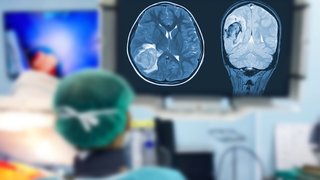
You may have heard famous athletes such as golf legend Tiger Woods, ace pitcher Max Scherzer, and tennis champ Rafael Nadal credit their quick recoveries from injuries to stem cell therapy or platelet-rich plasma therapy (PRP).
These therapies are forms of regenerative medicine, which leverages the body’s own healing capabilities to grow, repair, or replace damaged or diseased tissues.
In some cases, regenerative therapies may be used as an alternative to surgery for sports-related injuries such as ACL and rotator cuff tears, tendinitis, or spine or joint injuries.
Touted as way to get athletes and patients back in action faster, many regenerative therapies are fairly new, and some are still considered experimental.
At UT Southwestern we are excited about the promise of regenerative therapies and their ability to improve patients’ quality of life. At the Hamon Center for Regenerative Science and Medicine, our doctors and scientists are breaking new ground in regenerative therapies, including:
- Treating spine injuries with stem cells
- Rebuilding cell protein structures to promote cell growth
- Reversing osteoporosis bone loss
- Regenerating heart tissue
As an academic medical center, our Physical Medicine and Rehabilitation (PM&R) and Sports Medicine teams work closely together to ensure each patient gets the right treatment to give them the best outcomes.
If you are considering stem cell therapy or PRP for a musculoskeletal condition, we can talk you through what to expect and the evidence behind each option.

Stem cell therapies
What it is: Stem cells are the cells from which all other cells are generated. They can become any type of cell in the body, such as a muscle or tendon cell. Stem cells can be collected from a variety of places, including blood, fat, and bone marrow.
How it works: Stem cell therapy guides the formation of specific cells that can be used to potentially regrow or repair damaged tissue. For example, stem cells can be injected into a damaged patellar tendon in the knee to possibly develop healthy tendon cells to improve pain and function.
Pending research: Research is ongoing to determine whether stem cell therapy can improve degenerative conditions of the shoulder, knee, hip, and spine. Studies are also examining how stem cell therapy can help treat conditions such as spinal cord injury, leukemia, and perhaps one day, macular degeneration.
Platelet-rich plasma injections
What it is: Platelets are the cells in your blood that control and prevent bleeding – they play a key role in your body’s healing process. Plasma is the liquid portion of your blood (the rest is platelets and white and red blood cells). Platelet-rich plasma is produced when a sample of your blood is spun down in a centrifuge to isolate and collect the platelets, which are then added back to the plasma.
How it works: PRP therapy involves injecting concentrated platelets into damaged tissue to stimulate faster growth of new, healthy cells.
PRP and the devices used to create it are “cleared for use” by the FDA when applied to an orthopedic site when mixed with autograft and/or allograft bone prior to application. For the best outcomes and appropriate treatment, visit an academic medical center such as UT Southwestern.
Our doctors are part of a team of experts in many fields of medicine, including bone, muscle, nerve, and tissue health. We can point you to the most effective option and help prevent adverse reactions to PRP, which can include injection site irritation or infection, allergic reaction, skin discoloration, or development of blood clots.

Pending research: Some preliminary studies show that PRP may be effective in treating many soft-tissue injuries and joint conditions, including:
- Achilles or patellar tendonitis
- Arthritis in the major joints
- Severe arthritis may be better treated with join replacement surgery
- Damaged vertebral discs
- Certain sports-related injuries:
- Hip and thigh
- Knee and lower leg
- Shoulder
- Tennis elbow
However, more research is needed to definitively recommend PRP as a broad standard of care.
Who is a candidate for regenerative therapy?
We normally do not recommend regenerative medicine as a first line of treatment for most musculoskeletal injuries and conditions. While they are generally safe and possibly effective, we are continuing to gather evidence and data backing these therapies, and right now most insurance companies do not cover them.

At UT Southwestern Medical Center, our multidisciplinary team of doctors specializes in both surgical and nonsurgical treatments for musculoskeletal conditions in any part of the body, including an arm, elbow, leg, ankle, heel, or toe.
Before considering stem cell therapy or PRP, we typically recommend trying anti-inflammatory medication and physical therapy first. These therapies are enough to manage or heal the majority of minor to moderate musculoskeletal injuries.
However, if you need more intensive treatment, we may discuss regenerative medicine, either in lieu of or in conjunction with surgery.
A realistic approach
We pride ourselves in leading the way in advancing the care of musculoskeletal conditions through research and clinical trials. Our goal is to provide the most effective and least invasive therapy to help achieve your desired outcomes.
If your doctor recommends PRP or stem cell therapy for a musculoskeletal injury or condition, especially as a first line of treatment, consider getting a second opinion.
Regenerative medicine may prove to be a good option for you, particularly if you’re a competitive athlete or work in a physical job. However, it’s important to understand what these therapies can and can't do based on available data.
To visit with a PM&R or sports medicine expert, call 214-645-8300 or request an appointment online.










